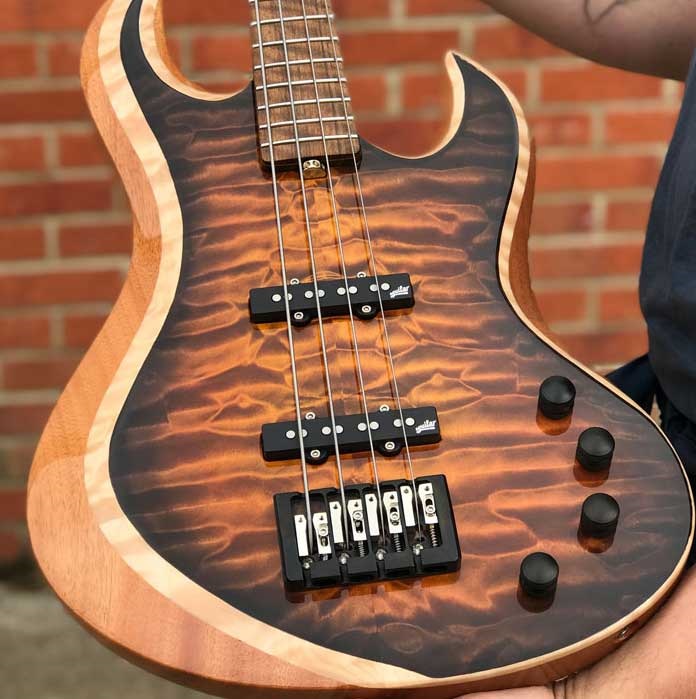See the business listing for this bass builder here
The feature bass this week is the first BOTW that’s a 12-string!
Builder Enrique Salmon writes:
I am a luthier and a gigging musician as well. I play bass in a fusion blues trio and have wanting to be able to add more unique tones and licks to the overall sound of our group. I have always been a fan of Tom Petersson of Cheap Trick and his 12 string bass and decided that I would build my own. I also appreciate the look and sound of the Rickenbacker 4000 series basses and based my design roughly on that. I began the process with the neck. I have had a long piece of Heritage Maple hanging around my workshop. There is a great exotic wood shop near where I live which is where I source most of my tone woods. Apparently this maple came from a old plantation building somewhere in North Carolina. I did some measurements and realized that the heritage maple would serve perfectly as the centerpiece of a neck-through design. For design contrast, balancing weight, as well as for its tonal qualities I laminated pieces of Afzelia on either side of the maple. After initial shaping of the body, neck, and headstock, I began the process of cutting the truss rod channels. Twelve strings create an enormous amount of tension on the neck. Therefore, I installed two truss rods I purchased from Stewart MacDonald. I like the look of Honduran Rosewood and used that for the fretboard. After determining the scale length of the bass and calculating the fret placements I carefully measured and cut the fret slots. I installed Wide/Medium frets that I got from Stewart MacDonald. The next step is to shape the radius of the fretboard followed by recutting the ends of the fret slots if needed. The neck binding is installed followed by some more shaping and smoothing. The next and crucial part of the process was to decide on what style of tuning I would use for this instrument. There are several ways to tune the four sets of three strings. This is important since the tuners that will be installed onto the head stock will require different spacing, placement, as well as different sized holes for the machines. After that step I focused on the placement of the pickups. It is important to first determine the scale length before hand-routing the pickup cavities as well as the placement of the bridge. Again, I liked the look of Rickenbacker Basses especially the bound body and neck. I hand-routed channels onto the neck and body for the binding and used vinyl adhesive for best installation of the plastic binding that I got from Stewart MacDonald. Finally the instrument was ready for the next step. After careful shaping, scraping, and sanding it was time for the finishing. Before spraying the nitrocellulose lacquer it is important to remove all leftover glues, oils, other other byproducts from the wood. I cleaned the wood with Behlen Naphtha, de-natured alcohol, and then a 4 to 1 mixture of water and ammonia. I began the lacquer process first with three coats of ColorTone sanding lacquer, carefully and lightly sanding with 220 sandpaper between each coat. This was followed by 8 light coats of ColorTone lacquer. After allowing the lacquer to cure for 10 days The final step of the finishing process is to polish the instrument with up to 800 grit polishing papers and compounds. Finally, it is time to install the pickups, bridge, and other hardware. I picked up a pair of JBE Rickenbacker style pickups from Split Rock Guitars as well as a Rickenbacker style bridge, pots, and three-way switch from Pick of the Ricks. I got the Pearloid top domed Volume and Tone knobs from Stewart MacDonald. I installed Gotoh tuners on the Headstock. The hardware installation process was completed with the strings. I used a set of SIT 12 String Electric Bass Power Steels. After all this work that took me about a month and a half it was time to plug the bass in and take it for a spin. I had a little trouble with the bridge pickup at first. It turns out that there was a grounding short. After fixing that things have been working great ever since and the guys in the band love the new addition to our sound.














Well done!
Want YOUR bass to be featured for Bass of the Week?
Submit yours now using our easy web form



It would be a great addition to the BOTW if there were sound clips/samples of the featured instrument. What do you think? Is this a possibility?
There is the option to provide a YouTube demo on the BOTW entry form https://bestbass.gr/bassoftheweek However, it is up to the builder whether to provide a demo or not.
I will see if I can produce a good recording of this bass. Give me a day or two.
Wow! Fantastic job! I’m an old school traditional 4 stringer & not normally attracted to such instruments until I saw yours. I’ll bet it plays as good as it looks, which would be beautiful! Thanks for unveiling it for the rest of us thumpers!
This bass IS lots of fun to play. Especially when I run it through my overdrive pedal and an Electro-Harmonix Enigma.
What kind of tuning do you use?
The E and A string trios are tuned to octaves. The D and G trios I tune in 4ths DgD and GcG.
Have you tried tuning the top strings DAD and GDG? That may be more useful… I’ve of one guy who used DF#A and GBD!
Is it a bass you can use on all songs or, because of the tuning, only on certain songs??
Are the extra 2 strings on E & A each tuned to ‘different’ octaves? Does this mean it sounds 3 times as full as a 12-string guitar?
Does it have an Oriental sound on the D & G?
Yes, I think a sound clip would be great!
BTW – Great Job!
Yes,
I normally play either a six string bass or P-bass for most of our tunes, but for some tunes I like to supplement the band’s overall sound with the 12 string. The higher two strings tuned in 4ths do lend a sort of exotic sound. The E and A strings are tuned to different octaves.
You are on drugs. I have played for 28 years and I can’t dream of playing something such as this. I play a custom P/J 4 string. Great sound and no silly mess such as this. The guitar looks great and it took a lot of work but go back to old school.
Best Regards (Bass Monkey)
To each his own, but please no more knockers. I have played for 45 years and play many different instruments , from four string fretted and fretless ,to five six and seven string basses, Each have their own sound and character and I enjoy them all, it does’t always have to be four string only!!
Yes well you’re doing what comes to you you’re faarting nose up…
This was one of the lines Paul McCartney used in the banter going on in the recording session of “Think for Yourself”.
1965 is the first time ANYBODY did something, “electronically” different with bass.
I don’t know how it was done, but Paul McCartney used his Hofner bass to play the clean lower end, and a Rickenbacker 4001 to play the “Fuzz Bass” part.
Bass played with distortion… I found myself a “RAT” distortion box and hooked it up.
I won’t say anymore. 😀 😀 😀
Many “Old Schoolers” have been the innovators and influential in how bass is played today.
I’m not a monster bass player, but I can hold my own in just about every type of music.
28 years wouldn’t even be preschool compared to the length of time William or I have been playing.
I’ve been playing for 51 years, William has been playing for 45 years and the one thing I can guarantee…
We’re both still learning and we’re both still dreaming of “what can I do different to get “that” sound?”
That could be the difference between us and monkeys.
William, what a beautiful instrument.
I look forward to hearing the sound you were looking for and how you’re using it.
Now if only you could add volume and tone control for each string.
Peace Brother
beautiful, just beautiful. I’ll bet it sounds monsterous!
I would love to hear this instrument just straight into the recorder. Where is Salmon Luthiery located?
I would like to hear a sound byte of the 12 string bass being played. I remember cheap tricks sound but I would like to hear it isolated
I play a 5 string bass. I wonder if a 15 string with the neck about the same size as a 5 string? Probably impractical.
What is the scale length?
It is a 33 inch scale length
I’m curious where the bridge came from? The whole thing looks great!